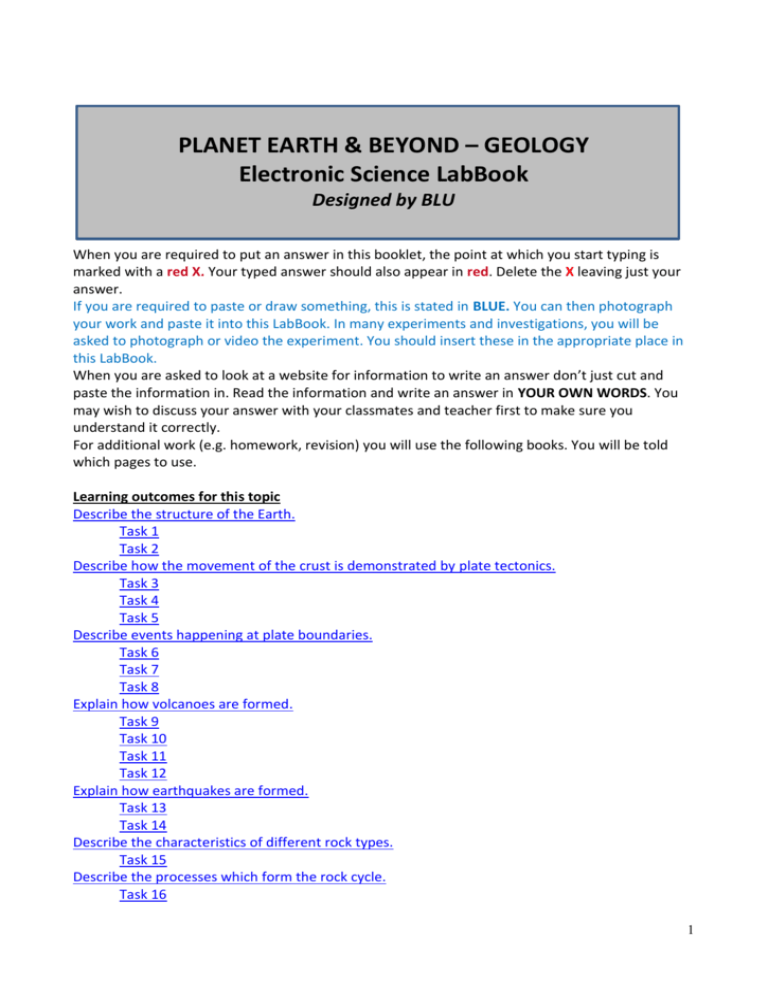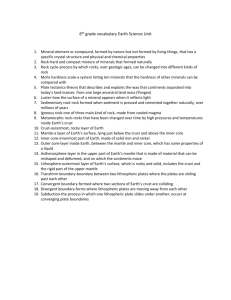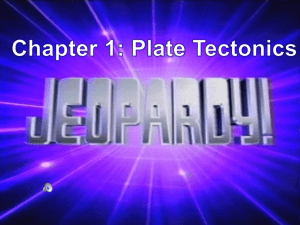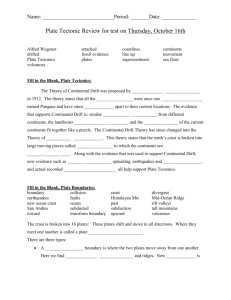File
advertisement

PLANET EARTH & BEYOND – GEOLOGY Electronic Science LabBook Designed by BLU When you are required to put an answer in this booklet, the point at which you start typing is marked with a red X. Your typed answer should also appear in red. Delete the X leaving just your answer. If you are required to paste or draw something, this is stated in BLUE. You can then photograph your work and paste it into this LabBook. In many experiments and investigations, you will be asked to photograph or video the experiment. You should insert these in the appropriate place in this LabBook. When you are asked to look at a website for information to write an answer don’t just cut and paste the information in. Read the information and write an answer in YOUR OWN WORDS. You may wish to discuss your answer with your classmates and teacher first to make sure you understand it correctly. For additional work (e.g. homework, revision) you will use the following books. You will be told which pages to use. Learning outcomes for this topic Describe the structure of the Earth. Task 1 Task 2 Describe how the movement of the crust is demonstrated by plate tectonics. Task 3 Task 4 Task 5 Describe events happening at plate boundaries. Task 6 Task 7 Task 8 Explain how volcanoes are formed. Task 9 Task 10 Task 11 Task 12 Explain how earthquakes are formed. Task 13 Task 14 Describe the characteristics of different rock types. Task 15 Describe the processes which form the rock cycle. Task 16 1 Describe the structure of the Earth. SciPad Pg 195 Task 1 Watch this video and use the interactive to make notes of the state, thickness and temperature of each layer https://www.youtube.com/watch?v=3MFr2cC3erk http://www.learner.org/interactives/dynamicearth/structure.html Inner core: X Outer core: X Mantle: X Crust: X What elements make up the core? X Task 2 The crust is broken into large pieces called plates. Find a picture of these plates and paste it in. X New Zealand is on the boundary of two plates – the X plate and the X plate. Plates are either continental or oceanic. Use this website to summarise the differences between the two types of plates. http://www.differencebetween.net/science/nature/difference-between-oceanic-and-continentalcrust/ Type of rock: Oceanic = X; Continental = X Which plate is thickest? X Which plate is the densest? X Which plate would “float” on top of the other if they collided? X 2 Describe how the movement of the crust is demonstrated by plate tectonics. Reference SW10 Pg 134-137 SciPad Pg 196-197 Task 3 Convection currents in the mantle move the plates which are floating on top of the mantle. Watch the videos to answer the questions https://www.youtube.com/watch?v=jkKlGXG4lG8 https://www.youtube.com/watch?v=ryrXAGY1dmE How does a convection current form? X What direction do the crust plates move when two convection cells are rising together? X What direction do the crust plates move when two convection cells are rising together? X This happens very slowly (about 2.5cm per year) but an idea of what it is like can be found in a lava lake in a volcano. The cooled lava is the crust and the movement of the hot lava underneath it is caused by convection currents. Note how old pieces of “crust” are pushed under and into the liquid lava to melt again. http://ngm.nationalgeographic.com/video/player#/?titleID=lava-lake-tectonics&catID=1 Task 4 Movement of the plates of the crust is called Continental Drift Use this video to complete the questions https://www.youtube.com/watch?v=_5q8hzF9VVE Briefly describe what continental drift is about X State the four pieces of evidence for continental drift X X X X Task 5 Use this animation to answer the questions http://www.phschool.com/atschool/phsciexp/active_art/continental_drift/ What is our name for the supercontinent that had all of the world’s land? X From 180-200 million years ago it started to break up, one of the new supercontinents was Gondwanaland (or just Gondwana). What present continents did it contain? X Have a go at reconstructing the supercontinent http://www.geo.cornell.edu/hawaii/220/PRI/continental_puzzle.html 3 Describe events happening at plate boundaries. Different events occur at the boundary between two plates. These events depend on how the plates are moving. Task 6 Describe the movement of the plates at: A divergent boundary: X A convergent boundary: X A transform boundary: X Task 7 Use this website to describe what features you can find at a convergent boundary http://www.learner.org/interactives/dynamicearth/slip2.html What happens to the oceanic plate when it hits a continental plate? X What are these zones called? X What two main geological features do you find at these zones? X What happens two continental plates collide? X What main geological feature do you find at these zones? Give an example. X Task 8 Use this website to describe what features you can find at a divergent boundary and a transform boundary. http://www.learner.org/interactives/dynamicearth/slip3.html How is new crust formed at a divergent boundary? X What two main geological features do you find at divergent boundaries? X What geological feature is formed at a transform boundary? X At every type of boundary rocks are put under stress and will break, releasing energy. What are these releases of energy called? X 4 5 Explain how volcanoes are formed. Reference SW10 Pg 146-153 SciPad Pg 198-201 Task 9 Here's a map of where Earth's volcanoes occur. Compare this to your tectonic plates map in Task 2. Do you notice anything? X There are two types of volcano – subduction volcanoes and hot-spot volcanoes. Task 10 http://www.aucklandmuseum.com/whats-on/exhibitions/volcanoes/volcanic-forces/what-goesdown%E2%80%A6 Where do subduction volcanoes occur? X Name some subduction volcanoes in New Zealand. X Why does NZ have so many subduction volcanoes? X Why is the boundary of the Pacific Ocean known as the “Ring of Fire”? X How does a subduction volcano form? X 6 What is the difference between lava and magma? X Task 11 http://www.aucklandmuseum.com/whats-on/exhibitions/volcanoes/city-of-volcanoes/city-onthe-spot Auckland has many hot-spot volcanoes. Describe how they are formed. X Task 12 What is the difference between active, dormant and extinct volcanoes? X Give NZ examples of: Active volcano: X Dormant volcano: X Extinct volcano: X 7 Explain how earthquakes are formed. Reference SW10 Pg 139-143 SciPad Pg 202-203 Task 13 Use this video to answer the questions https://www.youtube.com/watch?v=30SFfPvcss0 Why does energy get built up between moving plates? X The point where the rocks break is called the X. It is also called the focus. The energy of the earthquake is emitted as seismic waves. Describe the two main types: P-waves: X S-waves: X Which type of wave is the fastest (arriving first)? X What is the difference between the focus and the epicentre? X Surface waves (Rayleigh and Love waves) cause the most amount of damage. Why? X Task 14 Two different scales are used to measure earthquakes – the Richter scale and the Modified Mercalli scale. http://www.diffen.com/difference/Mercalli_Scale_vs_Richter_Scale What do these two scales measure? X 8 Describe the characteristics of different rock types. SciPad Pg 204 Task 15 Use the website to describe the characteristics of the three different rock types. http://www.learner.org/interactives/rockcycle/types.html Sedimentary How it is formed: X Characteristics: X Examples: X Metamorphic How it is formed: X Characteristics: X Examples: X Igneous How it is formed: X Characteristics: X Examples: X Igneous rock is split into volcanic igneous rock and plutonic igneous rock. Volcanic rock forms X the crust, has X crystals (it has cooled quickly) and may contain X. Examples are X Plutonic rock forms X the crust and has X crystals (it has cooled slowly). Examples are X. 9 Describe the processes which form the rock cycle. SciPad Pg 205 Use this interactive to answer the questions http://www.phschool.com/atschool/phsciexp/active_art/rock_cycle/ Task 16 Igneous rock What processes form igneous rock? X What is the main source of new igneous rock? X Metamorphic rock What processes form metamorphic rock? X Where are these conditions found? X Examples - Limestone (sedimentary rock) will change to Marble (metamorphic). Greywacke (sedimentary) will change to Schist (metamorphic). Think of the sedimentary rock being cooked and squeezed over a long period of time. Sedimentary rock Most rock that we see is sedimentary rock. What processes form sedimentary rock? X Weathering is breaking up of large rocks into smaller rock particles called X. The sediments are then transported away by erosion. Examples of erosion is by X The sediments will settle into layers by X (they get deposited onto the floor of the ocean). Over time the weight of these layers builds up and cements the sediments together to produce rock. 10







